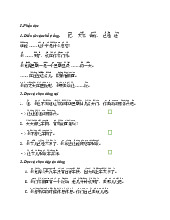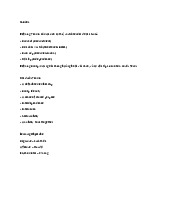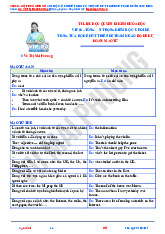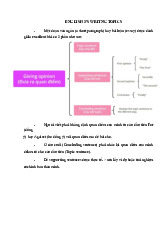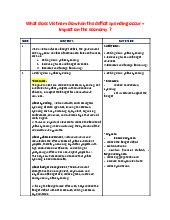







Preview text:
lOMoARcPSD|49830739
UBND TỈNH BÌNH THUẬN CỘNG HÒA XÃ HỘI CHỦ NGHĨA VIỆT NAM HỘI
ĐỒNG TUYỂN DỤNG Độc lập – Tự do – Hạnh phúc
DANH MỤC TÀI LIỆU ÔN TẬP MÔN TIẾNG ANH
KỲ TUYỂN DỤNG CÔNG CHỨC NĂM 2023
(Kèm theo Quyết định số 4954/QĐ-HĐTD ngày17 /11/2023 của Hội đồng tuyển dụng) I.
Nội dung ôn tập ngạch chuyên viên hoặc tương đương A. KIẾN THỨC NGÔN NGỮ 1. Personal Pronouns
2. Nouns and quantifiers 3. Modal verbs 4. Phrasal verbs 5. Articles 6. Prepositions 7. Adjectives 8. Adverbs 9. Comparison
10. Gerunds and infinitives 11. Common structures 12. Tenses
13. Conditional sentences 14. Relative clauses 15. Passive voice
B. NỘI DUNG CHI TIẾT
1. Personal pronouns (đại từ nhân xưng), possessive adjectives (tính từ sởhữu),
possessive pronouns (đại từ sở hữu), reflexive pronouns (đại từ phản
thân),object pronouns (tân ngữ đại từ)
Đại từ nhân xưng Tính từ Đại từ sở hữu sở hữu Chủ ngữ Tân ngữ
Đại từ phản thân 1 lOMoARcPSD|49830739 I Me My Mine Myself You You Your Yours Yourself/yourselves We Us Our Ours Ourselves They Them Their Theirs Themselves She Her Her Hers Herself He Him His His Himself It It Its Its Itself
2. Nouns and quantifiers
- Countable nouns: danh từ đếm được
Vd: a ball, two books, chairs, tables, students…
- Uncountable nouns: danh từ không đếm được Vd: bread, tea, water…
- Quantifiers: định lượng từ
Vd: some, many, much, a few, a little…
3. Modal verbs: động từ khiếm khuyết
- can, could, may, must, have to, should, need, will, shall… Vd: He can swim very well. 4. Phrasal verbs catch up/
catch up with bắt kịp fall
behind tụt lại đằng sau fill in điền vào get up
thức dậy give up từ bỏ
go off reo (chuông), nổ (súng)
go on tiếp tục grow up lớn lên
hurry up khẩn trương keep up bắt kịp
look after chăm sóc look up tra cứu
put on mặc vào take after giống take
off cởi ra (quần áo), cất cánh (máy bay)
try on thử (quần áo) turn on/off bật/ tắt
turn round quay lại turn up đến wash
up rửa chén watch out coi chừng ...
5. Articles: mạo từ - a, an , the
VD: I have a dog and a cat. The name of the dog is Lu Lu and the name of the cat is Tom 6. Prepositions: Giới từ 2 lOMoARcPSD|49830739
- Giới từ đi với thời gian, nơi chốn: in, at, on
- Giới từ theo sau tính từ:
VD: afraid of (sợ) , fond of (thích), excited about (vui mừng về)… 7. Adjectives: tính từ
- Possessive Adjectives: tính từ sở hữu
My, your, our, their, his, her, its - Possessive ‘s Vd: This is Lan’s book.
- Descriptive Adjectives: tính từ miêu tả
Vd: nice, big, beautiful, young, yellow…
8. Adverbs: Trạng từ
Vd: carefully, slowly, fast, hard… He drives very carefully
9. Comparisons of Andiectives and Adverbs: So sánh tính từ và trạng từ So sánh bằng So sánh hơn So sánh nhất - The + tính từ ngắn + - Tính từ ngắn +ER As + adj/adv + as EST - More + tính từ dài - The most + tính từ dài
- Một số trường hợp bất quy tắc:
+ good/ well à à better the best
+ bad/ badly à à worse the worst + far à farther à farthest
10. Gerunds and Infinitives: Danh động từ và động từ nguyên mẫu
- Bare infinitives: động từ nguyên mẫu được sử dụng sau:
+ Các động từ khiếm khuyết
+ Một số động từ: make, let, see, hear, feel, watch, notice
- To infinitives: động từ nguyên mẫu có ‘To’, được sử dụng sau các động từ:
Agree, arange, decide, expect, hope, intend, plan, promise, wish, would like… - Gerunds: danh động từ
+ Được sử dụng sau các cụm động từ: Be/get used to Can’t stand/bear Be busy Be accustomed to Can’t help Be worth It’s no good/use Look forward to Be fed up with + Sau các động từ: 3 lOMoARcPSD|49830739
Admit, avoid, consider, delay, deny, dislike, enjoy, finish, keep, mind, miss,
postpone, practise, suggest…
- Một số động từ được theo sau cả hai hình thức To infinitive và Gerund:
Begin, start, continue, forget, remember, regret, try, stop
11. Common structures: Một số cấu trúc thông dụng Used to Get/be used to Because Because of Although Inspite of/ despite So…that Such…that So that Too…to-V1 Enough…to-V1 In order to/ so as to 12. Tenses: các thì Thì Dạng thức 1. Simple present S + V1/-s/-es 2. Present continuous S + am/is/are + V-ing 3. Present perfect S + have/ has + V3/-ed 4. Present perfect continuous S + have/ has + been + V-ing 5. Simple past S + V2/-ed 6. Past continuous S + were/was + V-ing 7. Past perfect S + had + V3/-ed 8. Simple future S + will + V1 9. Future continuous S + will + be + V-ing 10. Near future S + am/is/are going to + V1 13. Conditional sentences
Loại câu điều kiện Mệnh đề IF Mệnh đề chính Loại 1: Hành động có thể Simple present Will/ can + V1 xảy ra ở tuơng lai Loại 2: Hành động không Simple past Would/could + V1 có thật ở hiện tại Loại 3: Hành động Past perfect Would have + V3/ed không có thật ở quá khứ - Unless = If … not
14. Relative clauses: Mệnh đề quan hệ 4 lOMoARcPSD|49830739
- Relative pronouns: WHO, WHOM, WHICH, WHOSE, THATVd: The man
who talked to you yesterday is my teacher.
- Relative Adverbs: WHEN, WHERE, WHYVd: This is the place where he was born.
15. Passive voice: Thể bị động Thì Bị động Hiện tại đơn S + am/is/are + V3/-ed Hiện tại tiếp diên
S + am/is/are + being + V3/-ed Hiện tại hoàn thành S + have/has + been + V3/-ed Quá khứ đơn S + was/were + V3/-ed Quá khứ tiếp diên S + was/were + being + V3/-ed Quá khứ hoàn thành S + had + been + V3/-ed Tương lai đơn S + will + be + V3/-ed
Vd: I gave her a present on her birthday.(chủđộng) She was given a
present on her birthday.(bị động). C. HÌNH THỨC KIỂM TRA.
Trắc nghiệm khách quan đa lựa chọn.
D.NỘI DUNG KIỂM TRA.
Ngữ pháp cơ bản, từ vựng, cụm từ, chức năng giao tiếp. II.Nội dung ôn tập
ngạch cán sự hoặc tương đương
A. KIẾN THỨC NGÔN NGỮ 1. Personal Pronouns 2. Nouns and quantifiers 3. Modal verbs 4. Articles 5. Prepositions 6. Adjectives 7. Adverbs 8. Comparison 9. Gerunds and infinitives 10. Common structures 11. Tenses 12 .Conditional sentences 13. Relative clauses 14. Passive voice
B. NỘI DUNG CHI TIẾT:
1. Personal pronouns (đại từ nhân xưng), possessive adjectives (tính từ sởhữu), possessive
pronouns (đại từ sở hữu), reflexive pronouns (đại từ phản thân), object pronouns (tân ngữ đại từ) 5 lOMoARcPSD|49830739
Đại từ nhân xưng Tính từ Đại từ
Đại từ phản thân sở hữu sở hữu Chủ ngữ Tân ngữ I Me My Mine Myself You You Your Yours Yourself/yourselves We Us Our Ours Ourselves They Them Their Theirs Themselves She Her Her Hers Herself He Him His His Himself It It Its Its Itself 2. Nouns and quantifiers
- Countable nouns: danh từ đếm được
Vd: a ball, two books, chairs, tables, students…
- Uncountable nouns: danh từ không đếm được Vd: bread, tea, water…
- Quantifiers: định lượng từ
Vd: some, many, much, a few, a little…
3. Modal verbs: động từ khiếm khuyết
- can, could, may, must, have to, should, need, will, shall… Vd: He can swim very well.
4. Articles: mạo từ - a, an , the
VD: I have a dog and a cat. The name of the dog is Lu Lu and the name of the cat is Tom 5. Prepositions: Giới từ
- Giới từ đi với thời gian, nơi chốn: in, at, on -
Giới từ theo sau tính từ:
VD: afraid of (sợ) , fond of (thích), excited about (vui mừng về)… 6. Adjectives: tính từ
- Possessive Adjectives: tính từ sở hữu
My, your, our, their, his, her, its - Possessive ‘s Vd: This is Lan’s book.
- Descriptive Adjectives: tính từ miêu tả
Vd: nice, big, beautiful, young, yellow…
7. Adverbs: Trạng từ
Vd: carefully, slowly, fast, hard… He drives very carefully.
8. Comparisons of Andiectives and Adverbs: So sánh tính từ và trạng từ So sánh bằng So sánh hơn So sánh nhất - The + tính từ ngắn + - Tính từ ngắn +ER As + adj/adv + as EST - More + tính từ dài - The most + tính từ dài
- Một số trường hợp bất quy tắc: 6 lOMoARcPSD|49830739
+ good/ well à à better the best
+ bad/ badly à àw orse the worst + far à à farther farthest
9. Gerunds and Infinitives: Danh động từ và động từ nguyên mẫu - Bare
infinitives: động từ nguyên mẫu được sử dụng sau:
+ Các động từ khiếm khuyết
+ Một số động từ: make, let, see, hear, feel, watch, notice
- To infinitives: động từ nguyên mẫu có ‘To’, được sử dụng sau các động từ:
Agree, arange, decide, expect, hope, intend, plan, promise, wish, would like… - Gerunds: danh động từ
+ Được sử dụng sau các cụm động từ: Be/get used to Can’t stand/bear Be busy Be accustomed to Can’t help Be worth It’s no good/use Look forward to Be fed up with + Sau các động từ:
Admit, avoid, consider, delay, deny, dislike, enjoy, finish, keep, mind, miss, postpone, practise, suggest…
- Một số động từ được theo sau cả hai hình thức To infinitive và Gerund:
Begin, start, continue, forget, remember, regret, try, stop
10. Common structures: Một số cấu trúc thông dụng Used to Get/be used to Because Because of Although Inspite of/ despite So…that Such…that So that Too…to-V1 Enough…to-V1 In order to/ so as to 11. Tenses: các thì Thì Dạng thức 1. Simple present S + V1/-s/-es 2. Present continuous S + am/is/are + V-ing 3. Present perfect S + have/ has + V3/-ed 4. Simple past S + V2/-ed 5. Past continuous S + were/was + V-ing 6. Simple future S + will + V1 7. Future continuous S + will + be + V-ing 8. Near future S + am/is/are going to + V1
12. Conditional sentences: Câu điều kiện
Loại câu điều kiện Mệnh đề IF Mệnh đề chính
Loại 1: Hành động có thể xảy ra ở tuơng lai Simple present Will/ can + V1 7 lOMoARcPSD|49830739
Loại 2: Hành động không có thật ở hiện tại Simple past Would/could + V1 - Unless = If … not
13. Relative clauses: Mệnh đề quan hệ -
Relative pronouns: WHO, WHOM, WHICH, WHOSE, THATVd: The man
who talked to you yesterday is my teacher. -
Relative Adverbs: WHEN, WHERE, WHYVd: This is the place where he
was born. 14. Passive voice: Thể bị động Thì Bị động Hiện tại đơn S + am/is/are + V3/-ed Hiện tại tiếp diên
S + am/is/are + being + V3/-ed Hiện tại hoàn thành S + have/has + been + V3/-ed Quá khứ đơn S + was/were + V3/-ed Quá khứ tiếp diên S + was/were + being + V3/-ed Tương lai đơn S + will + be + V3/-ed
Vd: I gave her a present on her birthday.(chủ động)
She was given a present on her birthday.(bị động)
C. HÌNH THỨC KIỂM TRA
Trắc nghiệm khách quan đa lựa chọn
D. NỘI DUNG KIỂM TRA
Ngữ pháp cơ bản, từ vựng, cụm từ, chức năng giao tiếp./.
……………………………………………… 8
